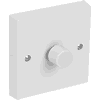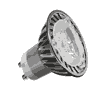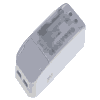Flickering lights can be a nuisance and annoying, here we look at some of the possible causes of flickering lights in the home which include,


Flickering lights can be a nuisance and annoying, here we look at some of the possible causes of flickering lights in the home which include,
Investigating the cause of flickering lights can be a very time consuming process, as with many electrical faults it is generally a process of elimination.
The easiest and first check to carry out is replace the lamp (light bulb), if the light continues to flicker then you should switch the light off and contact an electrician to investigate the flickering further. You should NOT attempt to rectify the issue yourself as you could make the situation worse which could also incur additional costs to rectify it properly.
Loose connections can be caused by vibration / disturbances, not tightened up enough in the first place, temperature changes or if the electrical installation is poorly maintained. Screw terminal connections can work loose over time, screw-less electrical termination connections (interconnections or splicing connectors) are now available which solves the issue of screw terminal connections working loose.
Loose connections could cause lights to flicker, the loose connection could be at the light switch (or switches if there is more than one light switch), at the light fitting or at an earlier point in the lighting circuit, i.e. at the light fitting immediately before the flickering light within the circuit.
If all of the lights on the same circuit or all of the lights in the property flicker then the issue could be elsewhere. Loose connections can also be a cause or a contributing factor in RCD tripping.

Incompatible dimmer switches can also cause the lights to flicker, especially LED lights. As LED lamps consume a significant amount of less power than traditional halogen or incandescent lamps a specific LED dimmer switch maybe required.
Dimmer switches are also available in varying maximum ratings, a dimmer switch should be selected based on the maximum demand required (allowing for a safety margin) and type of lamp it is required to dim. Manufactures can advise on the correct dimmer switch type and rating.
Some types of lamps are not dimmable so if you try to dim it it may flicker, flash, blink, not dim, or completely go off.
 Some light fittings require an extra low voltage transformer to reduce the voltage from mains voltage to generally around 12 volts. The ELV transformer could be an integral part of the light fitting or an external standalone transformer. If the transformer is faulty this may cause the light to flicker.
Some light fittings require an extra low voltage transformer to reduce the voltage from mains voltage to generally around 12 volts. The ELV transformer could be an integral part of the light fitting or an external standalone transformer. If the transformer is faulty this may cause the light to flicker.
Some ELV light fittings are connected to a single ELV transformer and some have their own ELV transformer per light fitting. ELV (extra low voltage) is some times mistakenly referred to as LV (low voltage). AC RMS LV = ≤ 1000 volts, ELV = ≤ 50 volts.
 Many types of modern lamps may contain electronics, should the internal electronics fail it may cause the light to flicker or flash. Lamps near the end of their serviceable life may also flash, blink or strobe. Replacing the lamp would be the first thing to try if it is blinking, flashing, strobing or randomly going on and off, should the flashing continue contact an electrician.
Many types of modern lamps may contain electronics, should the internal electronics fail it may cause the light to flicker or flash. Lamps near the end of their serviceable life may also flash, blink or strobe. Replacing the lamp would be the first thing to try if it is blinking, flashing, strobing or randomly going on and off, should the flashing continue contact an electrician.
 Lighting control gear are generally only used in commercial and industrial lighting, a faulty control gear could cause the light fitting to go off once it has warmed up, then when it has cooled down it may come back on, this sequence of events may continue until it fails completely.
Lighting control gear are generally only used in commercial and industrial lighting, a faulty control gear could cause the light fitting to go off once it has warmed up, then when it has cooled down it may come back on, this sequence of events may continue until it fails completely.
Possible Sequence of Events: turn the light on, after a while the light fitting goes off (the control gear has now warmed up), after a while the light fitting may come back on (the control gear has now cooled down).
 A faulty LED driver could also be a feasible cause of flickering lights. Most LED light fittings require an LED driver for the light to function correctly, LED drivers can look similar to LV transformers. A mismatch of LED lamp type or rating and LED driver type or rating may also cause an LED light to flicker or flash.
A faulty LED driver could also be a feasible cause of flickering lights. Most LED light fittings require an LED driver for the light to function correctly, LED drivers can look similar to LV transformers. A mismatch of LED lamp type or rating and LED driver type or rating may also cause an LED light to flicker or flash.
There are a number of other possible causes of flickering or flashing lights in the home, these range from faulty wiring, incorrectly installed light fittings or the fluctuation of the supply voltage.
LED light fittings and LED lamps contain a Light Emitting Diode (LED) chip, this chip can fail and when it does it can flash, blink or strobe on and off.
Faulty wiring within the home could be the cause of flickering lights, instruct an electrician to investigate any possible faults without delay.
An example of an incorrectly installed light fitting which may cause the lights to flicker could be that the light fitting has not been installed in accordance to the manufactures installation instructions by not removing the thermal insulation from covering the light fitting causing the light fitting to over-heat.
Electrical connection faults can include the incorrect connection of light switches and light fittings, for wiring guides see how to wire a light switch and how to wire a light fitting.
The fluctuation of the supply voltage may indicate an issue with the actual electricity supply to the property or building, an electrician can check the supply voltage, if an issue is found with the supply voltage then the local electricity distribution / system network operator (DNO / DSO) should be contacted immediately, calling 105 (from the UK) should get through to the correct operator.
Due to the very low power required to operate some LED light fittings or LED lamps, A common issue can be that the LED light will appear to still be on or glow when it is turned off.
A possible cause of this glow when the light is turned off could be caused by an induced voltage from another electrical cable into the cable supplying the glowing LED light fitting. Induced voltage from one electrical cable to another can occur when two or more electrical cables are run within the same vicinity i.e. run in parallel together for extended length of run. This small amount of induced voltage may just be enough the make the LED light glow.
Possible solutions to glowing LED lights caused by induced voltage could be to replace the LED light fitting with a different type of LED light fitting, install 1 or more additional lights to increase the load or fit a suitable dummy load to the light fitting or light switch.
It is not possible to dim the same light with more than one dimmer switch unless a specific lighting system is designed to accept two dimmer switches to control the same set of lights, this would normally require a lighting dimmer control panel.
As a standard dimmer or LED dimmer switch dim the light independently it is not possible to “un-dim” the light from a 2nd dimmer switch. Only the actual dimmer switch which originally dimmed the light can brighten (un-dim) it.
Trying to use two dimmer switches to control the same light may cause the lights to flicker.
Many types of lamps and light fittings naturally strobe, depending on the type of lamp this is normal and it is not normally visible to the human eye. The electrical frequency in the UK is 50Hz, in the USA it is 60Hz and the light strobing is usually at the frequency of the electrical supply. Sometimes this strobing effect is visible through a digital camera.
Since upgrading to LED lighting some people have commented that LED lighting gives them a headache (they maybe effected by the 50Hz / 60Hz strobe effect from the lamp).
As fluorescent lighting naturally strobes at 50Hz (UK) it has been a UK requirement that fluorescent lighting should not be connected to the same phase as single phase motors in the same area. The reason for this is because if the motor is rotating in sync with the 50Hz it could appear that the motor has stopped when actually it is still running.
To be notified of ongoing updates, news and future posts join our free Newsletter